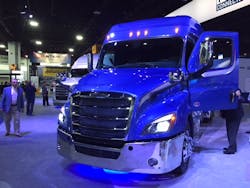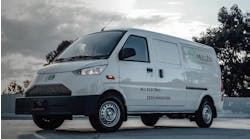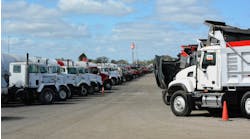ATLANTA. Roger Nielsen, president and CEO at Daimler Trucks North America (DTNA), explained in an interview here at the inaugural North American Commercial Vehicle (NACV) show that there is a growing move to more daycab orders in the Class 8 market as more fleets look at shorter lengths of haul and more last mile logistics business.
“We’ve seen a lot of larger fleets move towards the last mile logistics business; that’s being driven by e-commerce activity,” he explained in a sit-down interview with Fleet Owner. “We’ve seen a trend towards higher mix of daycabs as a result.”
Yet he added those are also increasingly “premium” daycabs that incorporate more driver comforts, safety technologies, and aerodynamic packages.
“In terms of e-commerce deliveries, the fewer ‘hand-offs’ you have, the faster and cheaper the service can be,” Nielsen noted. “So those trucks are going to operate on the highways and thus need the aerodynamics for fuel efficiency.”
In terms of overall commercial truck production rates for 2017, Nielsen said DTNA is sticking to its forecast of 365,000 Class 6-8 units for the North American Free Trade Agreement (NAFTA) market, with a possible 5% to 10% increase next year. “There’s optimism among fleet owners” in regards to freight activity, he explained.
Another big trend Nielsen is seeing centers of the importance of safety technology to the bottom line of motor carriers across a number of areas, from driver retention to reduction in insurance costs.
He added, too, that “safety technology” is now encompasses a far broader span of systems – including the transmission and cruise control.“Look at AMTs [automated manual transmissions]; we’re up to 95% now in [Freightliner] Cascadia orders. That’s because it not only expands the driver recruitment pool but it’s safer for driver’s to operate,” he noted. “The same goes with adaptive cruise control; in stop-and-go traffic it can reduce fatigue. That makes the driver safer”
Nielsen stressed that according to National Highway Transportation Safety Administration (NHTSA) data, 94% of accidents result from some type of human error.
“So anything that helps reduce that error – active lane keeping, blind spot detection, or AMTs – is going to lower accident rates, lower fleet liability exposure, and lower insurance costs” he said. “Driver’s see it as a form of job security, too, for an accident can lead to a loss of employment.”
Nielsen touched on several other topics during his wide-ranging interview with Fleet Owner:
- Alternative fuels still have a big role to play in trucking because the trucking industry “has a long memory” and remembers what it was like to pay $5 per gallon for diesel in the summer of 2008. “We are only one or two world events away from seeing process like that again,” he explained.
- Natural gas still has viability in trucking although the price differential between natural gas and diesel fuel “is not what it used to be” and “makes it harder to justify” investment in it, Nielsen noted. Still, DTNA plans to roll our more natural gas truck configurations in 2018, he said.
- There is “definitely a place” for battery-electric commercial trucks based on specific business use cases, such as in short haul operates, drayage, and in non-attainment areas where metropolitan air quality is an issue.
- Key to making battery-electric trucks work is the power-density of the battery package. That would cure the “range anxiety” that Nielsen believes is one of the biggest holdups to deploying all-electric truck.
- That’s also one reason why he said Daimler helped lead a $60 million investment push in Israeli start-up StoreDot earlier this month; a company whose battery technology can supposedly charge electric vehicles in a matter of minutes.
- One way around that logjam, however, would be to sacrifice more vehicle payload to add in more battery storage – a scenario Nielsen said can work in situations where trucks are not operated at full weight capacity. “In a lot of light-loaded applications, adding in 2,000 to 3,000 lbs. of energy storage would work,” he pointed out.




